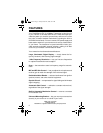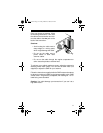
6
INTRODUCTION TO AMATEUR
RADIO
This transceiver is a great intermediate-level tool for the experi-
enced amateur radio operator. The transceiver opens a door for
you to the world from almost anywhere! All you need is an Ama-
teur Radio Operator’s License (Novice Class, or Technician Plus,
or higher) issued by the Federal Communications Commission
(FCC). If you do not have a license, it is easier than ever to get
one and help from licensed operators is available. Here are a few
tips to help you get started.
You can turn on your transceiver and scan the entire band to hear
what is going on;
however, do not attempt to transmit until
you get your license
. If you transmit without a license, you are
in violation of federal law. That violation can lead to severe pen-
alties. Note that ham operators take the FCC rules very seriously
and want nothing to do with “bootleggers” — their term for people
who operate without a license.
Find out if there is a ham radio club in your area. Most clubs wel-
come newcomers and are glad to help you get your license.
There are thousands of clubs across the country, so there is prob-
ably one in or near your own community. Often, the staff at your
local RadioShack store can help you locate a club.
If you do not hear anyone talking about a local club in your area
as you listen to local transmissions, write to the American Radio
Relay League (ARRL) at the following address, to find out how to
contact a local affiliate. The ARRL is the national organization
representing amateur radio in the United States. The league has
more than 150,000 members. Most are ham operators, or mem-
bers in the process of obtaining their license.
The American Radio Relay League
225 Main Street
Newington, CT 06111
http://www.arrl.org
19-1110.fm Page 6 Friday, March 24, 2000 9:42 AM


















